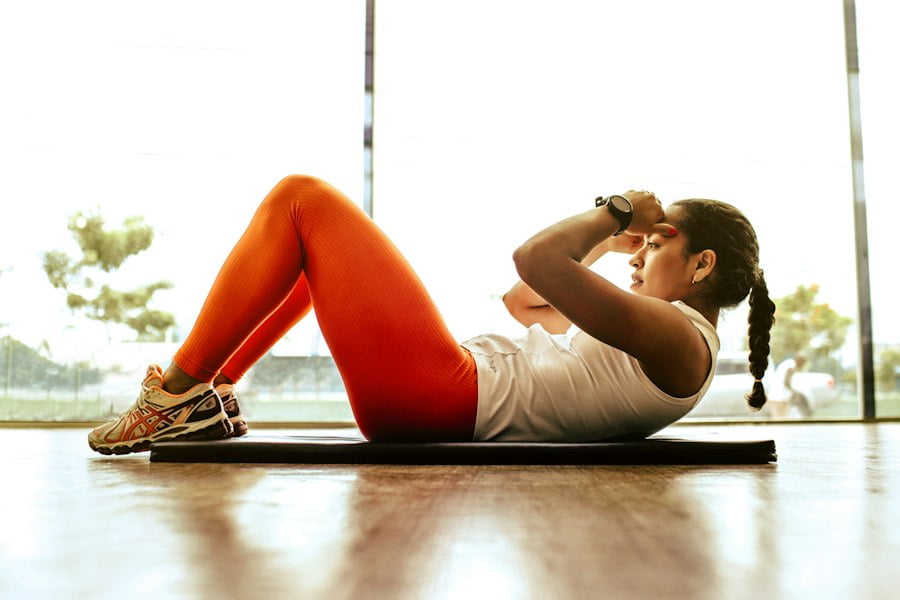
Gentle exercises for joint health
Joint health is crucial for maintaining an active and pain-free lifestyle. As we age, our joints can become stiff, achy, and prone to injury. However, incorporating gentle exercises into our daily routine can help improve joint health and alleviate these issues. Gentle exercises are low-impact activities that are easy on the joints, making them suitable for people of all ages and fitness levels.
One of the key benefits of gentle exercises is their ability to reduce joint pain and stiffness. When we engage in regular physical activity, it helps to lubricate the joints and increase blood flow to the surrounding tissues. This can help reduce inflammation and alleviate pain. Additionally, gentle exercises can improve flexibility and range of motion in the joints, making it easier to perform daily activities without discomfort.
Another advantage of gentle exercises is their ability to strengthen the muscles and joints. When we engage in weight-bearing activities, such as walking or resistance band exercises, it helps to build muscle mass around the joints. This provides added support and stability, reducing the risk of injury. Strong muscles also help to absorb shock and protect the joints during movement.
Key Takeaways
- Gentle exercises can benefit joint health by reducing pain and stiffness, improving flexibility and range of motion, and strengthening muscles.
- Common joint issues and causes include osteoarthritis, rheumatoid arthritis, and injury or overuse.
- Warm-up and stretching techniques are important for preparing the body for exercise and preventing injury.
- Low-impact exercises like walking, swimming, and cycling can be effective for joint health without putting too much stress on the joints.
- Chair-based exercises, yoga and Pilates, Tai Chi, resistance band exercises, and water exercises are all great options for gentle exercises that can improve joint health.
Understanding Joint Health: Common Issues and Causes
There are several common joint issues that can affect our overall well-being. Arthritis is one of the most prevalent conditions, characterized by inflammation and stiffness in the joints. It can be caused by a variety of factors, including age, genetics, and lifestyle choices. Bursitis is another common joint problem that occurs when the bursae (small fluid-filled sacs) become inflamed. This can cause pain and limited mobility in the affected joint. Tendinitis is a condition that involves inflammation of the tendons, which connect muscles to bones. It often occurs as a result of overuse or repetitive motions.
The causes of joint problems can vary depending on the specific condition. Aging is a common factor that contributes to joint issues, as the cartilage in our joints naturally wears down over time. Injuries, such as sprains or fractures, can also lead to joint problems. Additionally, overuse of a joint, such as repetitive motions or excessive strain, can cause wear and tear on the surrounding tissues. Other factors that can contribute to joint problems include obesity, poor posture, and certain medical conditions.
Preparing for Gentle Exercises: Warm-Up and Stretching Techniques
Before engaging in any form of exercise, it is important to properly warm up the body to prevent injury. A warm-up routine helps to increase blood flow to the muscles and joints, preparing them for physical activity. It also helps to loosen up the muscles and improve flexibility. Some effective warm-up exercises include marching in place, arm circles, and gentle neck rolls. These movements help to gradually increase heart rate and body temperature.
Stretching is another important component of preparing for gentle exercises. Stretching helps to improve flexibility and range of motion in the joints. It also helps to lengthen the muscles and reduce muscle tension. Some safe and effective stretching techniques for joint health include calf stretches, hamstring stretches, and shoulder rolls. It is important to hold each stretch for at least 15-30 seconds and avoid bouncing or jerking movements.
Low-Impact Exercises: Walking, Swimming, and Cycling
Low-impact exercises are ideal for joint health because they minimize stress on the joints while still providing a cardiovascular workout. Walking is one of the easiest and most accessible low-impact exercises. It can be done anywhere and at any time, making it a convenient option for people of all ages. Walking helps to strengthen the muscles around the joints and improve overall joint health.
Swimming is another excellent low-impact exercise that is gentle on the joints. The buoyancy of water reduces the impact on the joints while providing resistance for a full-body workout. Swimming helps to improve cardiovascular fitness, strengthen muscles, and increase flexibility. It is particularly beneficial for people with arthritis or joint pain.
Cycling is a low-impact exercise that can be done indoors or outdoors. It helps to improve cardiovascular fitness, strengthen the leg muscles, and increase joint flexibility. Cycling can be done on a stationary bike or a regular bicycle, depending on personal preference and accessibility. It is important to adjust the seat height and handlebar position to ensure proper alignment and minimize strain on the joints.
Chair-Based Exercises: Upper and Lower Body Workouts
Chair-based exercises are a great option for people with joint problems or limited mobility. These exercises can be done while sitting in a chair, making them accessible for individuals who may have difficulty standing or balancing. Chair-based exercises can help improve muscle strength, flexibility, and range of motion in the joints.
For upper body workouts, some effective chair-based exercises include seated arm circles, shoulder shrugs, and bicep curls using resistance bands. These exercises help to strengthen the muscles in the arms, shoulders, and upper back. They also help to improve posture and reduce tension in the neck and shoulders.
For lower body workouts, some effective chair-based exercises include seated leg lifts, ankle circles, and seated squats. These exercises help to strengthen the muscles in the legs and hips. They also help to improve balance and stability.
Yoga and Pilates: Improving Flexibility and Balance

Yoga and Pilates are two forms of exercise that focus on improving flexibility, balance, and core strength. These practices can be particularly beneficial for joint health as they help to lengthen the muscles and improve range of motion in the joints.
Yoga involves a series of poses that are held for a certain period of time. It helps to improve flexibility, balance, and strength. Some yoga poses that are beneficial for joint health include downward dog, child’s pose, and warrior pose. These poses help to stretch and strengthen the muscles around the joints, improving overall joint health.
Pilates is a form of exercise that focuses on core strength and stability. It involves a series of controlled movements that target the deep muscles of the abdomen and back. Pilates can help improve posture, balance, and flexibility. Some Pilates exercises that are beneficial for joint health include the hundred, the bridge, and the single leg stretch. These exercises help to strengthen the core muscles and improve overall joint stability.
Tai Chi: A Mind-Body Exercise for Joint Health
Tai chi is a mind-body exercise that originated in ancient China. It involves slow, flowing movements combined with deep breathing and mental focus. Tai chi can be particularly beneficial for joint health as it helps to improve balance, flexibility, and strength.
Some tai chi exercises that are beneficial for joint health include the cloud hands, the single whip, and the brush knee. These exercises help to improve balance and coordination while gently stretching and strengthening the muscles around the joints.
Resistance Band Exercises: Strengthening Muscles and Joints
Resistance band exercises are a great way to strengthen the muscles and joints without putting excessive strain on them. Resistance bands are portable and versatile, making them suitable for people of all fitness levels.
Some resistance band exercises that are beneficial for joint health include bicep curls, tricep extensions, and lateral raises. These exercises help to strengthen the muscles in the arms and shoulders, providing added support to the joints.
For lower body workouts, some effective resistance band exercises include squats, lunges, and leg presses. These exercises help to strengthen the muscles in the legs and hips, improving overall joint stability.
Water Exercises: Hydrotherapy for Joint Pain Relief
Water exercises, also known as hydrotherapy, can be highly beneficial for relieving joint pain and improving joint health. The buoyancy of water reduces the impact on the joints, making it an ideal exercise option for people with arthritis or joint pain.
Some water exercises that are beneficial for joint health include water walking, water aerobics, and water jogging. These exercises help to improve cardiovascular fitness, strengthen muscles, and increase joint flexibility. The resistance of the water provides a gentle yet effective workout for the joints.
Tips for Safe and Effective Gentle Exercises for Joint Health
When engaging in gentle exercises for joint health, it is important to keep a few key tips in mind. First and foremost, it is important to start slowly and gradually increase intensity. This allows the body to adapt to the new exercise routine and reduces the risk of injury.
It is also important to listen to your body and stop if you experience pain or discomfort. Pain is a sign that something is wrong, and pushing through it can lead to further injury. If you experience persistent or severe pain, it is important to consult with a healthcare professional.
Lastly, it is always a good idea to consult with a healthcare professional before starting a new exercise program, especially if you have any pre-existing medical conditions or concerns. They can provide guidance and recommendations based on your individual needs and goals.
In conclusion, gentle exercises are an excellent way to improve joint health and alleviate pain and stiffness. Whether it’s walking, swimming, yoga, or resistance band exercises, there are plenty of options available for people of all ages and fitness levels. By incorporating these exercises into our daily routine and following proper warm-up and stretching techniques, we can improve flexibility, strengthen muscles and joints, and enhance overall joint health.
FAQs
What are gentle exercises for joint health?
Gentle exercises for joint health are low-impact physical activities that help improve joint mobility, flexibility, and strength without putting too much stress on the joints.
What are the benefits of gentle exercises for joint health?
Gentle exercises for joint health can help reduce joint pain and stiffness, improve joint flexibility and range of motion, increase muscle strength and endurance, and enhance overall physical function and well-being.
What are some examples of gentle exercises for joint health?
Examples of gentle exercises for joint health include walking, swimming, cycling, yoga, tai chi, Pilates, and low-impact aerobics.
Who can benefit from gentle exercises for joint health?
Gentle exercises for joint health can benefit people of all ages and fitness levels, especially those with joint pain, arthritis, or other joint-related conditions.
How often should I do gentle exercises for joint health?
It is recommended to do gentle exercises for joint health at least 3-5 times a week for 30 minutes each session. However, it is important to consult with a healthcare professional before starting any exercise program.
What precautions should I take when doing gentle exercises for joint health?
When doing gentle exercises for joint health, it is important to start slowly and gradually increase the intensity and duration of the exercise. It is also important to listen to your body and stop if you experience any pain or discomfort. Additionally, it is recommended to wear appropriate footwear and use proper equipment to prevent injury.


















